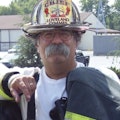On Dec. 28, 2015, Firefighter Barrett Dorner of the Toledo (OH) Fire & Rescue Department (TFRD) turned out the way we all do for a dwelling fire. As we’ve read in this column for many years, your weeks, months, years or decades of experience and training all play out when and if things go wrong. The reason we mention this is because it is so critical to practice, train and study your job each and every day. You never know when THAT run comes in. Every day is a training day.
Last month, Dorner shared with us the play-by-play of his fall into a basement during a house fire. This month, we’ll reflect on the incident and focus on lessons learned.
Incident recap
Dorner and his crew were dispatched to the scene of a one-and-a-half-story, early 1900s house, with light smoke drifting from the eaves. Dorner forced the door, and the fire was right in front of them. Instead of walking the straight line to the back right corner of the room, Dorner walked the Alpha (front) wall, turned at the Bravo (left-side) wall, clearing the area quickly. With one step, the floor gave way and he fell into the basement.
Dorner landed on his back. He quickly grabbed his mic and called a mayday: “Mayday, mayday, mayday. We have a firefighter who fell through the first floor into the basement about 10 feet in. I’m OK, there’s no fire in the basement, I just need help out.”
He stood up and crewmembers tried to help him out of the hole. Two members of another crew then came down the basement stairs and led him up the stairs and out the Delta (right) side door. Dorner was ultimately able to rejoin the crew, going back to work on the fire.
Lessons learned from Firefighter Dorner
I wish I brought my 4-foot hook in to be able to sound the floor as I went. I’ll make more of an effort of that, even if it means carrying the irons and my hook. (Note from Chief Goldfeder: While irons/Halligan can work as a “sounding” device, a longer tool gives us a bit more of a safer working area as we crawl through.)
I shouldn’t have let my guard down as much as I did. The visual evidence was there, but my gut told me at the door something was off. I started suspicious, and should have stayed suspicious. Gut feelings are absolutely a trustworthy sense; listen to them, always.
Self-rescue and crew-rescue techniques are critical. We’ve trained on those techniques over and over, but talking about them when we got back to quarters after a real-world event reinforced what options we could have used in the context of “what-if” the incident played out differently.
If there had been fire in the basement, I have full faith Nick would have either knocked it from above or handed down the line and given me the chance to survive. My first priority if this happens again with a conscious, separated firefighter is quickly getting the line in a place to defend him.
I should have created a better mental picture of the home in my head. I knew where the first to second-floor stairs were, but didn’t think about the location of the basement stairs until 7’s crew appeared. This is something I could have done earlier. Knowing the type of home and location of the other stairs, this should have been a no-brainer, but wasn’t.
Maydays don’t have to be LUNAR—just get out the information you need to, usually where, what and who. Keep that mic open as long as you have to, because once you let go, the amount of radio communication may quite literally “bonk” you to death. Talk and keep talking until you’ve got it all out.
Enjoy life. A slow day can turn in an instant. And while we’re still more likely to die in a car accident driving to work, we have a job that guarantees we’re going into harm’s way and gives us no guarantee of coming out.
This is one of those close calls that we enjoy writing about because there was no tragic ending. It’s a chance to learn without mourning, and that’s always a good thing.
Notes from Chief Goldfeder
Gut. I love my gut: Not the one that I should reduce in size, but rather the “gut feeling” that comes with training and experience. As Dorner points out, follow your gut and err on the side of doing more than less when it comes to our operational success. If something doesn’t feel right, there is a good chance it isn’t right. When you get that feeling, pause and size up the conditions, again. Determine what the outside crews are seeing. Identify what other conditions may be creating your concern. Trust your gut as a part of never-ending training and built-up experience.
Firefighter rescue: Recent reviews of mayday and firefighter trapped data indicates that most firefighter rescues are accomplished by the “in trouble” firefighter themselves. After that, immediate crews (physically nearby) will assist in the rescue, and a small percentage of firefighter rescues are actually accomplished by the RIT team. Why do I mention this? Because YOU are the one most likely to get yourself in trouble—and you’re the most likely to get yourself out of trouble if it happens. Because of that, there has never been a more critical time for all of us as firefighters to be as well trained, skilled, practiced and ready (including fit) to HELP OURSELVES if and/or when that bad incident occurs.
Letting our guard down: This may be normal—but it’s a problem. It can be easy to drift away from what we were trained—or what our policies (and related policies) dictate. Scott Snook’s book (Friendly Fire, 2000) talks about “practical drift” theory and helps us understand why we “drift” from what we are trained and are expected to do. He refers to the behavior that produces disasters such as the accidental shooting down of the Black Hawk helicopters in Iraq. As you may recall, in 1994, there was a “friendly fire” accident where two U.S. Air Force F15 fighter jets patrolling the no-fly zone over northern Iraq shot down two U.S. Army Black Hawk UH-60 helicopters. Twenty-six peacekeepers lost their lives. It is critical for anyone in any fire service leadership role to read and understand Snook’s work. He can help us better understand that fire departments rely on plans and procedures, and it is proven that personnel will often seek to find an easier, cheaper, faster or better way of achieving the task. This leads to “the slow steady uncoupling of practice from written procedure”—and we drift.
Hoselines flowing water: Nothing has been proven to be more effective to improve conditions than a hoseline flowing water. If you are going in, have a charged hoseline. If you are going in without a charged hoseline, such as for a search, make sure the engine crew is right there with you, with a charged line. It IS what’s best for any potential victims in harms way and it allows you to make that rescue as needed.
Know the building: If you can’t do a 360, make sure someone can. Quickly. In many departments today, a 360 must be conducted by the first-arriving company officer. Sometimes that works; sometimes it has to be passed to a later-arriving firefighter or officer. Regardless of how you get it done, get it done, especially on any single-family dwelling where the opportunity is there. Certainly some structures won’t allow that “instant” 360, but almost every single-family dwelling will. What’s your department’s procedure, and when is it done? What does the radio report sound like? Be sure to let command (and all listening to the radio) know what you see and how it may impact operations (smoke or fire showing, access, egress, basement, hazards, etc.).
The mayday: Who and where are you? That’s among the best info we can use when you are in trouble. Be sure to also include anything else that can help responding crews get you out. Of course, it’s all dependent on the condition you are in. Essentially, if you think we should know it, say it. Others on the fireground: When a mayday is transmitted, shut up. Radio time is always precious but now it has never been more precious than now. Let command run the incident without interference. Take time to read and drill (and drill and drill) on your department’s mayday procedures.
Chiefs, pay attention: When the troops are conducting these drills, you have a great opportunity to be “command” on the radio and train on what YOU would do in a mayday situation. Coaches, take time to train with the team well before the “game.”
Closing thought
Take note when Dorner tells you to enjoy life. Good thoughts. And while off-duty “enjoy” is critical, on-duty “enjoy” means drilling and practicing, every shift, every day on realistic hands-on training scenarios (or for volunteers not doing shifts, drill every week), so we can all enjoy that off-duty time.
Our sincere thanks to Firefighter Dorner for sharing this account with us so that we can all learn from his experience. Additionally, thanks to Chief Luis Santiago, Chief of Department, as well as Battalion Chief John Kaminski and all TFRD members for their support and assistance.
About the Author
Billy Goldfeder
BILLY GOLDFEDER, EFO, who is a Firehouse contributing editor, has been a firefighter since 1973 and a chief officer since 1982. He is deputy fire chief of the Loveland-Symmes Fire Department in Ohio, which is an ISO Class 1, CPSE and CAAS-accredited department. Goldfeder has served on numerous NFPA and International Association of Fire Chiefs (IAFC) committees. He is on the board of directors of the IAFC Safety, Health and Survival Section and the National Fallen Firefighters Foundation.

